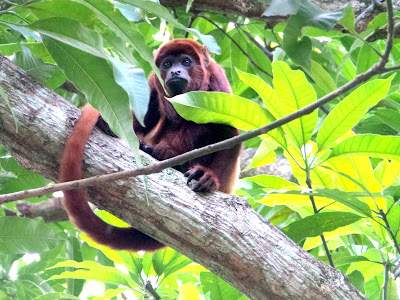I want to tell you a story about a miracle that happened this morning. It is very rare for a howler monkey to fall out of a tree. But it happened this morning, just by my kitchen door. One of the older mango trees stands there. Through age, some of the upper branches are rotten and, in this heavy rainy season, are falling to earth. It happened that a young Araguato female was on a heavy branch when it broke. The monkey fell some thirty meters but first striking a branch halfway down. At that moment I was in the kitchen and went out to discover the cause of the noise.
There on the ground and quite still was the monkey I quickly examined her for broken bones and found no injury. This was a miracle. To fall that great height and still be in one piece. The monkey began to move. Obviously confused. I picked her up and took her to one of our enclosures. I released her. The enclosure is very large and she was already climbing high and fast. My intention was to observe her for a short time before returning her to the wild. But really my concern was wasted. She was fine. Now the problem was to catch her and take her to the door. All this time she was calling. Sud
denly the trees above the enclosure were alive with araguatos. First a very large female landed on top of the enclosure, put her arms through the wire and cuddled the little girl. As if to say there there mummy is here. Then papa arrived with the rest of the family. I counted eighteen monkeys. This was the whole family. Now getting her out of the enclosure was no easy matter. Me atop a ladder, not something elderly gentlemen should do. I caught her and took her to the gate releasing her at the same time. She shot away. Mother took her in both arms and then together they departed, together with her big family.
Anyone who tells you that howler monkeys lack empathy should take note. No mother could top the concern and devotion that this mother showed.
This is the first time in eighteen years of associating with howler monkeys that I have observed a monkey fall from a tree without human cause.
Her survival can only be regarded as a miracle. I was humbled by the the love and devotion that this mother showed her child.
The troop showed no fear of me They proved to me yet again that they regard Cañaote as a safe haven. My picture, the little girl probably about six months, in the arms of a helper.
Un Milagro.
Quiero contarles una historia acerca de un milagro que ocurrió esta mañana. Es muy raro que un mono aullador se caiga de un árbol. Pero sucedió esta mañana, justo en la puerta de mi cocina. En uno de los árboles de mango grande que mas destaca allí. A través de los años, algunas de las ramas superiores están podridas y, en esta temporada de lluvias fuertes, están cayendo a la tierra. Sucedió que un joven Araguato femenino estaba en una rama pesada cuando esta se rompió. El mono cayó de unos treinta metros, pero primero golpear una rama hasta la mitad. En ese momento yo estaba en la cocina y salí a descubrir la causa del ruido.
Allí, en el suelo y muy quieto estaba el mono que rápidamente lo examine para ver si tenia algún huesos roto y no encontré ninguna lesión. Este fue un milagro. Por caer de tan gran altura y estar todavía bien. El mono comenzó a moverse. Obviamente confundido. La cogí y la llevé a uno de nuestros recintos. La solté. El recinto es muy grande y ella ya estaba subiendo alto y rápido. Mi intención era observarla por un corto tiempo antes de su regreso a la vida silvestre. Pero en realidad mi preocupación fue en vano. Ella estaba bien. Ahora el problema era para atraparla y llevarla a la puerta. Todo este tiempo ella estaba llamando. De repente los árboles por encima del recinto estaban llenos con araguatos. En primer lugar una gran mona aterrizó en la parte superior de la jaula, metía sus brazos a través del alambre y abrazaba a la niña. Como para decir: no te preocupes mano esta aquí. Entonces papá llegó con el resto de la familia. Conté dieciocho monos. Esta era toda la familia. Ahora sacarla del recinto no era cosa fácil. Me monte en una escalera, no es algo para señores mayores pero tenia que hacerlo. Yo la cogí y la llevé a la puerta para liberar la. Ella corrio y la madre se la llevó en ambos brazos y luego juntos se fueron, junto con su gran familia.
Cualquiera que te diga que los monos aulladores carecen de empatía debería tomar nota. Ninguna madre podría superar la preocupación y la devoción que esta madre mostró.
Esta es la primera vez en dieciocho años de asociación con los monos aulladores que he observado una caída del mono de un árbol sin causa humana.
Su supervivencia sólo puede ser considerado como un milagro. Me sentí humilde por el amor y la devoción que esta madre mostró a su hija.
La tropa no mostró miedo de mí. Demostraron una vez más que ellos consideran Cañaote como un refugio seguro. Mi imagen, la niña probablemente de unos seis meses, en los brazos de un ayudante.




















